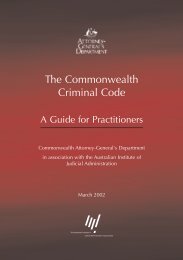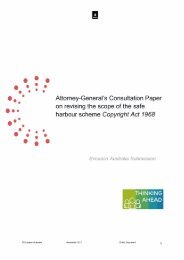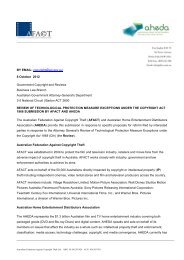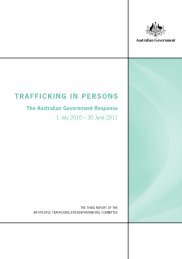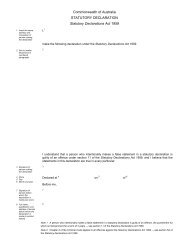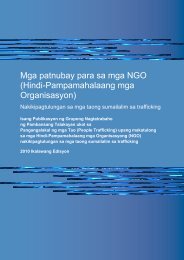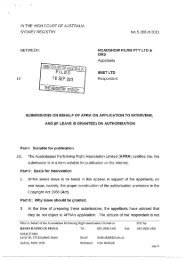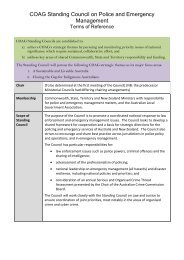Normann Witzleb [PDF 657KB] - Attorney-General's Department
Normann Witzleb [PDF 657KB] - Attorney-General's Department
Normann Witzleb [PDF 657KB] - Attorney-General's Department
Create successful ePaper yourself
Turn your PDF publications into a flip-book with our unique Google optimized e-Paper software.
15 The two-pronged test proposed by the ALRC and the VLRC is intended to raise the<br />
threshold for privacy claims. However, there are at least four reasons why the specific<br />
formulation of the test chosen raises concerns. First, the test of ‘highly offensive’ is<br />
inherently vague. While this may not be problematic as long as courts are able to give<br />
adequate and consistent content to the test, 22 its vagueness makes it difficult to use<br />
this criterion as an exclusionary device. Second, the tests of ‘reasonable expectation of<br />
privacy’ and ‘highly offensive’ are partly overlapping. Where conduct is likely to cause<br />
substantial offence, it can be reasonably expected that the defendant will not engage in<br />
it and respect the plaintiff’s privacy. Both of these points are also borne out when<br />
Gleeson CJ’s statement in Lenah about the suggested use of that criterion is considered<br />
in full:<br />
Certain kinds of information about a person, such as information relating to<br />
health, personal relationships, or finances, may be easy to identify as<br />
private; as may certain kinds of activity, which a reasonable person, applying<br />
contemporary standards of morals and behaviour, would understand to be<br />
meant to be unobserved. The requirement that disclosure or observation of<br />
information or conduct would be highly offensive to a reasonable person of<br />
ordinary sensibilities is in many circumstances a useful practical test of what<br />
is private. 23<br />
16 It becomes evident that, in that passage, Gleeson CJ was concerned with identifying<br />
when information or conduct was private, rather than whether disclosure or observation<br />
should be actionable. Furthermore, Gleeson CJ did not propose a two-pronged test that<br />
required both a reasonable expectation of privacy as well as offensiveness of the<br />
defendant’s conduct. Instead, his Honour identified the ‘highly offensive’ criterion a<br />
useful guide to ascertain whether information or conduct was private. This differs from<br />
the recommendations by the ALRC and the VLRC to use it as a threshold criterion to<br />
identify the seriousness of a privacy invasion.<br />
17 Thirdly, the offensiveness of behaviour is always dependent on its specific context. It<br />
is difficult to determine the degree to which conduct is offensive unless the totality of<br />
circumstances, including potential justifications for that conduct, are also considered.<br />
This creates the difficulty that the public interest in the information or other defences<br />
may become enmeshed in the enquiry of whether the defendant seriously interfered<br />
with the plaintiff’s privacy. 24 Whether a privacy breach was serious or not, can<br />
realistically only be determined in light of all the circumstances, including those relating<br />
to the defendant. 25 This is the reason why English courts consider the test to be relevant<br />
22 See generally, J Dietrich, ‘Giving Content to General Concepts’ (2005) 29 Melb ULR 218.<br />
23 Australian Broadcasting Corporation v Lenah Game Meats Pty Ltd (2001) 208 CLR 199, [2001] HCA 63,<br />
at[42].<br />
24 See also Lord Nicholls in Campbell v MGN Ltd [2004] 2 AC 457; [2004] UKHL 22, at [22]; Mark Warby,<br />
Nicole Moreham, Iain Christie (ed), Tugendhat and Christie: The Law of Privacy and the Media, 2 nd ed,<br />
OUP, Oxford, 2011, at [5.09].<br />
25 See also Gavin Phillipson, ‘Privacy in England and Strasbourg compared’ in Andrew T Kenyon and<br />
Megan Richardson (eds), New Dimensions in Privacy Law: International and Comparative Perspectives,<br />
CUP, Cambridge, 2006, 184, at 199 (supporting the use of the ‘offensiveness’ test for assessing the<br />
‘overall impact of the entire publication’ rather than as a threshold test).<br />
7


![Normann Witzleb [PDF 657KB] - Attorney-General's Department](https://img.yumpu.com/26247895/7/500x640/normann-witzleb-pdf-657kb-attorney-generals-department.jpg)

